
12 minute read
First Smart-Enabled HDB Homes in Punggol Northshore completed A range of technologies have been used
FIRST SMART-ENABLED HDB HOMES IN PUNGGOL NORTHSHORE COMPLETED
A range of technologies have been used.
Northshore Residences I & II - the first two smart-enabled housing precincts in Punggol Northshore, Singapore’s first smart and sustainable district.
Smart living in residential estates developed by the Housing & Development Board (HDB) has come to fruition, with the completion of Northshore Residences I and II - the first two smart-enabled housing precincts in Punggol Northshore. In line with Singapore’s vision of a Smart Nation, Punggol Northshore is the first public housing district to testbed smart technologies right from the design stage, to enhance the planning, design and maintenance of HDB estates, in order to bring about a more liveable, efficient, sustainable and safe living environment. As of 14 December 2020, about 85% (1,192 out of 1,402) of home owners from Northshore Residences I and II have collected their keys. These flats are equipped with smart distribution boards and smart sockets to help residents monitor their energy consumption. They also support the adoption of smart home solutions and applications developed by commercial companies, more easily, within their homes. The smart distribution board replaces the conventional distribution board in HDB flats, enabling residents to monitor electricity usage across household appliances. In addition, smart sockets are provided in every bedroom, living room and kitchen within the flat. Similarly, residents can track the energy usage of a home appliance, such as a television set, when it is plugged into the smart socket. In turn, residents will be able to effectively moderate the use of their home appliances, enabling them to save electricity and reduce their utility bills.
The completion of the first smart precincts in Punggol Northshore is a major milestone in HDB’s smart journey which started in 2014. The delivery of these smart homes also caps off Year 2020, where HDB marks 60 years of transforming Singapore’s public housing landscape, with significant shifts towards well-designed, smart, sustainable and community-centric towns in the last 10 years. As HDB enters its seventh decade, it will continue to tap on smart solutions and adopt bold ideas to create the best possible homes for Singaporeans. - Dr Cheong Koon Hean, Chief Executive ” Officer, HDB

Environmental modelling helps to inform the design of open spaces, placement of amenities like playgrounds, as well as optimise the building layouts and orientation to capture wind flow and promote natural ventilation.
SMART LIVING AT PUNGGOL NORTHSHORE
Beyond the improvements in the flats, HDB has also implemented other smart initiatives in Punggol Northshore to make daily living more convenient and comfortable for residents. For example, in the planning and design of the district, HDB carried out environmental modelling, to simulate the interaction of environmental factors such as wind flow, the amount of sunlight falling on a surface, and the casting of shadows. As a result, more greenery has been planted in potential hotspots to lower the ambient temperature, while outdoor amenities such as playgrounds are sited in well-shaded locations, thereby creating a more pleasant living environment. Residents can also look forward to more reliable estate services, with sensors to monitor and issue alerts when maintenance of common amenities, such as lights or lifts, is required. These facilities or fittings can then be checked and any issue identified can be resolved promptly, with minimal disruption to services. In addition, estate management will be more efficient, with the introduction of new technologies, such as smart lighting at common areas, that adjusts illumination levels, based on human traffic patterns, thus reducing energy consumption.
In September 2014, HDB announced the ‘Smart HDB Town Framework’, which mapped out how HDB intends to harness Information and Communication Technology (ICT) to introduce the ‘Smart’ element in public housing, to achieve a more liveable, efficient, sustainable, and safe living environment. The framework covers five key domains - Smart Planning; Smart Environment; Smart Estate; Smart Living; Smart Community. Punggol Northshore, one of seven waterfront housing districts in Punggol town, will be the first district to incorporate smart features across the whole district. Envisioned to be ‘A Smart and Sustainable District’, it is Punggol’s first district to test-bed smart technologies in public housing, right from the design stage, to enhance the planning, design and maintenance of HDB estates. The smart technologies implemented in Punggol Northshore under the five key domains are as follows:
Smart Planning
• The use of computer simulation and data analytics will enable HDB to improve the way it plans and designs its towns, precincts and buildings, and also derive optimal and cost-effective solutions to achieve sustainability goals. Real-time data is integrated into simulation models to derive the optimal and most cost-effective solutions for urban design technologies in HDB towns. • For example, environmental modelling of microclimatic conditions facilitates the urban planning and design process to create a green and comfortable living environment. Studies on wind flow, temperature, the amount of sunlight falling on a surface, and the casting of shadows were carried out at Punggol Northshore
District to aid decision-making during the planning and
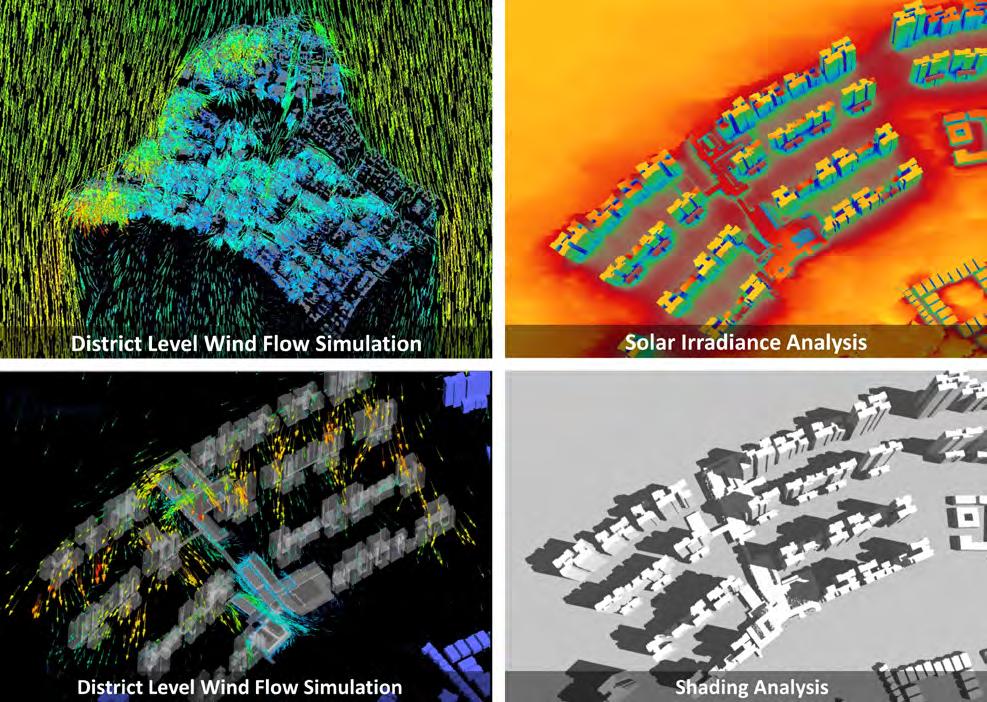
Environmental modelling aided decision-making during the planning and design of Punggol Northshore District.
design process. Through environmental modelling, potential hotspots were identified, where greenery could be introduced to bring down ambient temperature; well-shaded locations were identified, to place outdoor amenities such as playgrounds and fitness corners; and optimal locations were identified, for future installation of solar panels. The Integrated Environmental Modeler (IEM) builds on the design technology that HDB has been developing through the years. Treelodge@Punggol was the first HDB project to be planned using simulation tools that optimise environmental factors. The IEM was previously trialled on a small scale in Punggol and later used in enhancing the planning of Bidadari.
Smart Environment
• Smart initiatives have been deployed in Punggol to improve estate maintenance. For example, through the implementation of a network of sensors, a ‘Smart
Environment’ can be created. The sensors will capture real-time information on factors such as resource utilisation (energy & water), waste generation and the environment, providing insights that can help improve estate services by integrating, managing, and analysing data from various sources.
Smart Estate
• To improve estate services, HDB will leverage Smart technologies to collect and analyse data that helps to optimise maintenance cycles and preempt potential problems. • A central data repository for the collection, integration, management, processing and analysis of data collected from a network of estate sensors in products performing key functions, e.g. lighting, water pumps, lifts and solar panels, is being developed. This will enable HDB to monitor the health of estate services in real-time, allowing for quick detection of issues, optimised maintenance cycles, proactive upgrading and replacement of systems, and identifying opportunities where resources could be saved. This could, in turn, help to minimise disruption of services and reduce inconvenience for residents. • Smart Lighting in common areas will be sensor-controlled and equipped with predictive data analytics tools to understand human traffic patterns. Lighting in common areas, with little or no human traffic detected, could be reduced to 30%, potentially saving as much as 60% on energy usage. • Smart Irrigation uses moisture sensors and considers the various factors that may affect the amount of
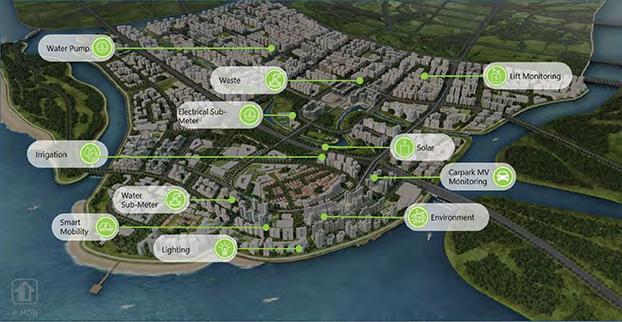
Sensors have been deployed in Punggol to improve estate maintenance.
water retained in the soil (e.g. rainfall and exposure to sunlight) to optimise plant watering schedules and usage. This is a water-efficient and less labour-intensive approach to maintain greenery and landscaping. • Smart Parking uses automation and real-time technological capabilities to provide for seamless entry and exit of vehicles, dynamic allocation of available lots, and in-app alerts for ease of payments, as well as reminders if users have parked in unauthorised lots.
Smart Living
• Smart-Enabled Homes will be equipped with additional infrastructure, such as additional power and data points at strategic locations, as well as smart sockets and a smart distribution board in Northshore
Residences. The smart distribution board replaces the conventional distribution board in HDB flats, enabling residents to monitor electricity usage across household appliances. Similarly, smart sockets are provided in every bedroom, living room and kitchen within the flat for residents to track the energy usage of home appliances when they are plugged into the smart socket. With the appropriate ICT infrastructure in place, residents will be able to enjoy more convenience and energy savings, when they adopt compatible smart home solutions and applications developed by commercial companies.
Smart Community
• HDB also leverages data analytics and ICT to better understand and engage residents, based on their demographics, social trends and lifestyle preferences. This
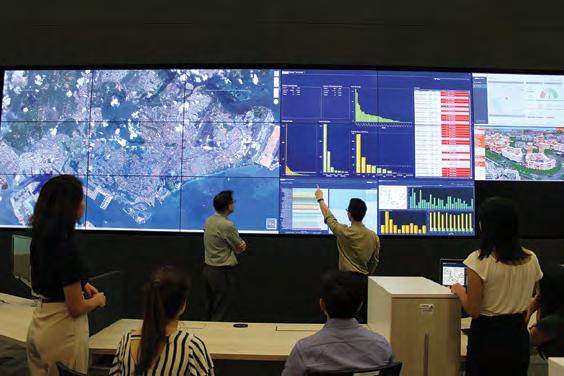
The Smart Hub, akin to a ‘brain’ of estate operations, enables HDB to monitor estate services in real-time.
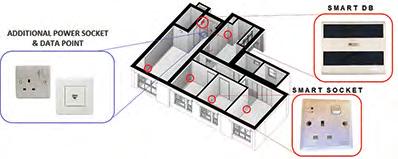
Barrier-free car park entrance and exit at the smart HDB car park in Northshore Residences.

can enhance community-building efforts and empower communities to co-create their living environments with HDB. • HDB launched the Pulse of the Heartlands initiative, in collaboration with tech companies, to develop an ecosystem of applications and services that will be useful to residents. The development of such an ecosystem will leverage the digital capabilities of a new Artificial
Intelligence (AI) and data platform, which comprises information on HDB towns, such as on shops in the neighbourhood. Over time, the platform will be enriched with more datasets, as other public agencies and private companies come on board to offer more types of data, such as location and availability of transport and car park facilities. App developers can tap on the platform’s data to build more applications, and as users interact with these applications over time, the data platform will collect more insights on residents’ interests, which could inform future planning and management of community facilities. • HDB also embarked on the ‘New Urban Kampung’ research programme, a study on social behaviour, undertaken together with Singapore University of
Technology and Design (SUTD), in 2017. This in-depth, multi-disciplinary study combines the fields of behavioural studies, Computational Social Science and
Urban Informatics, to predict how the demographics in
HDB towns are likely to evolve. It also attempts to forecast residents’ behaviour and responses to initiatives introduced in their living environment so as to help
HDB improve the design of the towns.
Tapping on data from traditional surveys and sensor networks around the estate, and through engaging the community, HDB believes it can better understand residents’ preferences and create new housing solutions in tandem with their evolving needs and aspirations.
A MORE CONVENIENT AND SEAMLESS PARKING EXPERIENCE
From January 2021, residents living in Northshore Residences I and II, and their visitors, are expected to benefit from a new generation parking system which offers a seamless and more convenient parking experience. The Smart Parking system, Parking@HDB, is the latest addition to the suite of smart features in the district. Parking@HDB includes various features aimed at improving the parking experience for residents and motorists:
Seamless entry and exit for motorists
Motorists can seamlessly enter and exit the car park. Gantry barriers will no longer be put up at the car park entrance and exit, as vehicle plates are registered via cameras.
More payment options for short-term parking charges
Motorists parking for a short period are encouraged to download the Parking@HDB app at Apple App Store or Google Play Store, so that they have the additional option of paying their parking charges via credit or debit card, through the app. The smart parking system detects their vehicles when they enter the car park and automatically activates the parking session through the app. Parking charges will be automatically deducted when they exit the car park, without the need for motorists to manually activate the app. With this, motorists need not insert their cash cards into the In-vehicle Unit (IU), nor worry about insufficient funds.
Lot availability is signalled by the overhead light indicators, enabling motorists to locate available lots quickly.
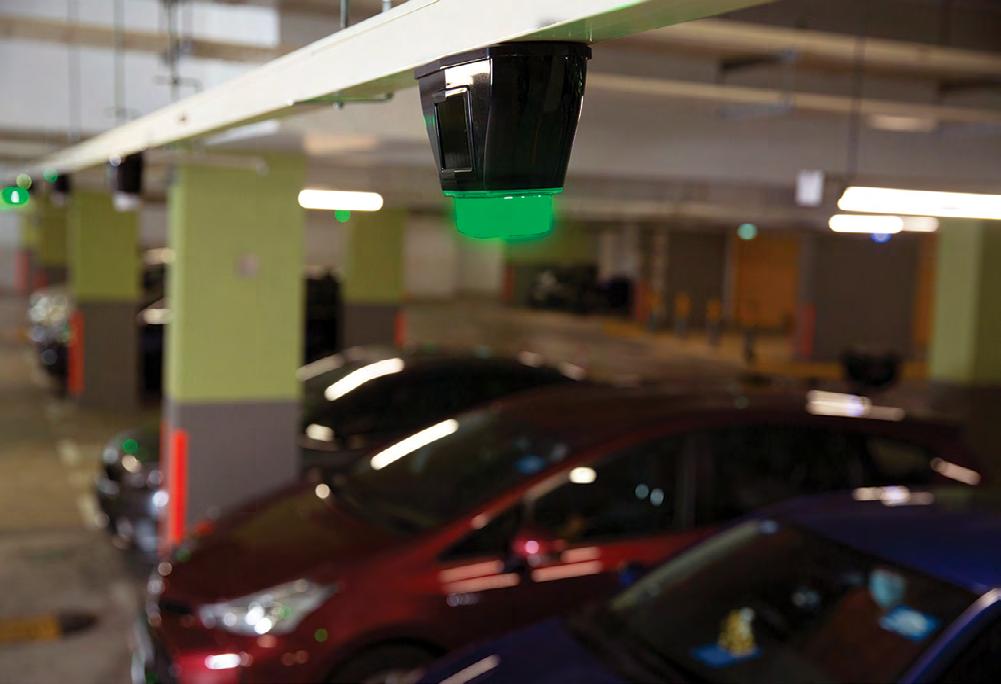
For motorists who do not have the Parking@HDB app, the parking charges will continue to be deducted from their cash card in their IU.
Efficient parking experience
To provide greater convenience to motorists when searching for available lots, colour-coded LED overhead guidance indicators have been installed above every parking lot to signal lot availability. A green colour means the lots are available for short term parking, while an amber colour means the lots are reserved for season parking. The light indicator will be switched off for occupied lots.
In-app alerts for motorists
Motorists who park short term will receive in-app notifications in real-time, at the start and at the end of their parking sessions, and will also be notified of the incurred charges. Smart cameras are installed in the car park to detect motorists who park illegally. Motorists who park in an unauthorised lot will receive an automated alert informing them to shift their vehicles, if they have downloaded the app. Those who do not remove their vehicle will face a fine. Motorists without the app will not receive such a notification. Instead, the system will alert HDB to administer the enforcement, backend. This will allow for automated enforcement round-the-clock, to ensure more orderly parking for the benefit of both motorists and residents.
Flexible allocation of parking lots
HDB will be able to better cater to the parking needs of season parking ticket holders and visitors, more flexibly and effectively. Based on the data collected on car park usage, the system will automatically allocate parking lots to meet varying demands on a real-time basis. For example, during the day when demand for short-term parking is high and season parking lots are not fully occupied, the system will increase the lots for short-term parking, by adjusting the light indicators from amber (indicating a season parking lot) to green (indicating availability for short-term parking). Conversely, the number of available lots for short-term parking will be reduced in the evening to ensure sufficient lots for season parking, when residents return home. This will allow an efficient and dynamic allocation of parking lots to meet motorists’ needs throughout the day.

All images by HDB

Motorists will be notified at the start and at the end of their parking sessions, and will also be notified of the parking charges.




